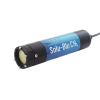Pro-Oceanus Mini Dissolved CH4 Probe
Features
- Compact size with low power consumption
- Large selection of concentration ranges
- Internal data logger with 2GB flash memory
- Expedited repair and warranty service
- Lifetime technical support
- More
Overview
The Pro-Oceanus Mini CH4 instrument uses infrared detection to measure the partial pressure of CH4 gas dissolved in liquids. Conversion to dissolved methane concentration is simple with known temperature and salinity values.
Mechanics
Mini CH4 submersible instruments are compact, lightweight, plug-and-play sensors designed to measure pCH4 for a range of applications. The instrument also measures total dissolved gas pressure (TDGP), a useful parameter for many applications and data correction.
Applications
With resistance to most corrosive liquids, the Mini CH4 can provide reliable dissolved methane data for many applications. Flow-through and inline adapters are also available for simple industrial solutions.
| Sensor Performance | |
|---|---|
| pCH4 Measurement Ranges | 0-1% CH4 ; by volume (~0-300 μg/L; by mass) 0-10%v/v (~0-3 mg/L) 0-100%v/v (~0-30 mg/L) |
| Total Dissolved Gas Pressure | 0-2 bar |
| Accuracy: pCH4 | ± 3% of max range |
| TDGP | ± 1% |
| Equilibration rate (t63) | ~8 minutes (with water-pumped head) |
| Resolution | 0.1% of max range |
| Physical | |
|---|---|
| Length | 28 cm (11 in) |
| Diameter | 5.3 cm (2.1 in) |
| Weight | Air 0.53 kg (1.2 lbs) Water: -0.06 kg (-0.1 lbs) |
| Housing Material | Acetal Plastic |
| Depth Rating | 0 - 600 m |
| Water Temperature | 0º to 40º C |
| Electrical | |
|---|---|
| Input voltage | 7-24 VDC |
| Power consumption | 85 mW (7 mA @ 12 V) |
| Data output | Digital: RS-232, ASCII format |
| Sample rate | 2 seconds (variable rate with logger/controller) |
All models include:
- Mini CO2 Instrument
- USB memory stick with Oceanus Software and User’s Manual
- QuickStart Guide
Power and communications deck box includes:
- Water-Resistant deck box with Underwater Cable and Connector Sleeve
- 2-meter RS-232 cable
- RS-232-to-USB Converter
- AC to DC 12 V Power Supply
Internal rechargeable battery models include the items above as well as a battery pack and charger.
In The News
Wildfire Prevention in the Sierra Nevada Region with the Yuba Watershed Institute
Though recent wildfires have sparked new conversations about wildfire management and response, groups like the Yuba Watershed Institute have been monitoring the forests and water resources of the Sierra Nevada region for decades, managing approximately 5,000 acres of land with the Bureau of Land Management (BLM) and about 7,000 acres in private land partnerships. The goal of the Institute is to work with local communities and land agencies to improve watershed and forestry management through informed practices and public outreach. The goals of the Yuba Watershed Institute are three-fold: Improve the ability of fire suppression agencies like the California Department of Forestry and Fire Protection ( CAL FIRE ) and the US Forest Service.
Read MoreWave Sensors Integration with NexSens Buoys: A Cutting-Edge Solution for Wave Measurment
Real-time wave data supports accurate weather prediction, safe and efficient maritime operations, and provides valuable safety and operating condition information for recreation and commercial fishing. Understanding wave dynamics also helps with the design of protective coastal structures like seawalls, breakwaters, and jetties. It also supports better prediction of their impact on sediment transport and coastal geomorphology. Wave data is a key factor in qualifying and designing offshore wind farms and harnessing kinetic energy for electrical generation. It helps with the understanding of ocean-atmosphere interactions and contributes to studies of sea-level rise and climate change impacts.
Read MoreSpring 2025 Environmental Monitor Available Now
In the Spring 2025 edition of the Environmental Monitor, we highlight partnerships across the world and the importance of collaboration between government agencies, universities, environmental groups, local communities, and other stakeholders. From great white shark research in Cape Cod to monitoring fisheries in Lake Erie, this latest edition underscores partnerships that connect stakeholders in a watershed through environmental data. With an emphasis on data sharing, a combination of real-time and discrete sampling keeps the public and partners informed of environmental conditions. Our writers also sought out science professionals dedicated to working with peers within and outside of the environmental sector.
Read More





























